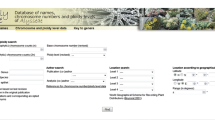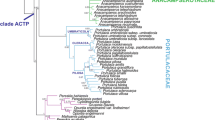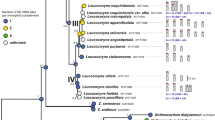Abstract
At present there is karyological information on ca 10% of the species and ca 30% of the genera of the Apocynaceae. Basic numbers of x = 6, 8, 9, 10, 11, 12, 16, 18, 20, 21 and 23 have been assessed. Of these x = 11 is primitive, occurring in ca 60% of the genera.
Those of x = 6, 8, 9 and 10 have evolved by reduction, and x = 12 by increase from x = 11. In the subtribe Secondatiinae however, x = 12 is most likely the result of doubling x = 6. The numbers x = 16, 18 and 20 are likewise doubles of x = 8, 9 and 10 respectively. Those of x = 21, 23, and in one case, x = 20 are probably aneuploid products of doubles of x = 11.
The two larger subfamilies, Plumerioideae and Apocynoideae have the basic numbers x = 8, 9, 10 and 11 in common and are not separable on the basis of chromosomal evidence. The third small subfamily Cerberoideae is more homogeneous according to basic number, i.e. x = 10 and 20. Most genera are characterized by a constant basic number, but some have two basic numbers; these clearly are cases of infrageneric aneuploidy. Based on records in the literature two closely related generaApocynum andTrachomitum appear to be characterized by a basic number of x = 8 as well as x = 11. This conflicting situation should be clarified by further karyological research. From the level of subtribe onwards some taxa have one basic number, but others are characterized by two or more numbers. The occurrence of similar basic numbers in different phylads of the family is considered to be the result of similar chromosomal evolution mechanisms.
Approximately 22% of the investigated species are polyploid. Intrageneric polyploidy occurs with a frequency of about 12.5% and infraspecific polyploidy with less than 4%.
The karyotypes observed are symmetrical: the chromosomes within a karyotype are similar in length with primary constrictions usually in a median position. In the Tabernaemontaneae however, it was observed that the karyotypes comprise one pair of distinctly heterobrachial chromosomes in addition to the metacentric ones. This tribe is also characterized by chromosomes which are relatively long.
Most genera of the African continent, which are well known regarding their chromosome number, are characterized by x = 11. Exceptions areStrophantus (x = 9) with a mainly tropical African distribution. Two other genera with derived numbers, i.e.Gonioma with x = 10 andPachypodium with x = 9, occur in southern Africa and Madagascar. The genera with a non-African distribution are less known for their chromosome number. However, the available evidence suggests that evolution of derived numbers has occurred more frequently outside Africa than on this continent.
Similar content being viewed by others
References
Arends J. C. & Van der Laan, F. M., 1979, Chrom. Numb. Rep. LXV. Taxon 28: 637.
Banerjee, P. K., 1974, Structural alteration of chromosomes in the evolution of Plumeria. Bull. bot. Soc. Bengal 28: 57–62.
Barink, M. M., 1983, A revision of Pleioceras Baill., Stephanostema K. Schum. and Schizozygia Baill. (Apocynaceae). In: Series of revisions of Apocynaceae XI X111 (ed. Leeuwenberg). Meded. Landbouwhogeschool Wageningen 837.
Baumberger, H., 1970, Chromosomenzahlbestimmungen und Karyotypanalysen bei den Gattungen Anemone. Hepatica und Pulsatilla. Ber. schweiz. bot. Ges. 80: 17–95.
Bawa, K. S., 1973. Chromosome numbers of tree species of a lowland tropical community, J. Arnold Arb. 54: 422–434.
Beek. T. A. ter, Verpoorte, R., Baerheim Svendsen, A., Leeuwenberg, A. J. M. and Bisset, N. G., 1984, J. Ethopharmacology 10: 1–156.
Beentje, H. J., 1982, A monograph on Strophanthus DC, Meded. Landbouwhogeschool Wageningen 824.
Bir, S. S., Guljeet Singh & Gill, B. S., 1984. Chrom. Numb. Reports LXXXII. Taxon 33: 128.
Datta, P. C. & Maiti, R. K., 1972, Relationships of Plumiereae (Apocynaceae) based on Karyology. Bull. bot. Soc. Bengal. 26: 9–19.
Ehrendorfer, F., 1981. Speciation patterns in woody Angiosperms of tropical origin. In: Progress in clinical and biological research. vol. 96, A. R. Liss, New York.
Ehrendorfer, F., Krendl, F., Habeler, E. & Sauer, W., 1968, Chromosome numbers and evolution in primitive Angiosperms. Taxon 17: 337–468.
Federov, A. (ed.), 1969, Chromosome numbers of flowering plants. Ac. Sc. U.S.S.R. Leningrad.
Fritsch, R., 1970, Chromosomenzahlen yon Pflanzen der Insel Kuba I. Kulturpflanze 18: 189–197.
Fritsch, R., 1972, Chromosomenzahlen von Pflanzen der Insel Kuba II. Kulturpflanze 19: 305–313.
Goldblatt, P., 1981. Index to plant chromosome numbers 1975–1978, Missouri bot. Gard.
Goldblatt, P,. 1984, Index to plant chromosome numbers 1979–1981, Missouri bot. Gard.
Grant, V., 1982a, Periodicities in the chromosome numbers of the Angiosperms, Bot. Gaz. 143: 379–389.
Grant, V., 1982b, Chromosome number patterns in primitive Angiosperms, Bot. Gaz. 143: 390–394.
Guljeet Singh, Bir, S. S. & Gill, B. S., 1982. Chrom. Numb. Rep. LXXVII, Taxon 31: 776.
Hill, L. M., 1984, Chrom. Numb. Rep. LXXXIV, Taxon 33: 537.
Jong, B. H. J. de, 1979. A revision of African species of Alstonia R.Br. (Apocynaceae). Meded. Land bouwhogeschool Wageningen 79-13.
Leeuwenberg, A. J. M., 1980, Loganiaceae in Engler. A. & Prantl, K.: Die natürlichen Pflanzenfamilien. Bd 28, bl.
Levan, A., Fredga, K. & Sandberg, A. A., 1965, Nomenclature for centromeric position on chromosomes, Hereditas 52: 201–209.
Löve, A. & Löve, D., 1982, Chrom. Numb. Rep. LXXV. Taxon 31: 352.
Mangenot, S. & Mangenot, G., 1957. Nombres chromosomiques nouveaux chez diverses Dicotyledones et Monocotyledones d'Afrique occidentale, Bull. Jard. bot. (Bruxelles) 27: 639–654.
Moore, D. M., 1982. Flora Europaea check-list and chromsome index, Cambridge University Press.
Moore, R. J., 1973, Index to plant chromosome numbers for 1967–1971, IOPB, Oosthoek, Utrecht.
Moore, R. J., 1974. Index to plant chromosome numbers for 1972. IOPB, Oosthoek, Scheltema & Holkema, Utrecht.
Moore, R. J., 1977. Index to plant chromosome numbers for 1973–1974, IOPB, Bohn, Scheltema & Holkema, Utrecht.
Rao, P. N. & Mwasumbi, L. B., 1981, Chromosome number reports LXXII. Taxon 30: 694–708.
Raven, P., 1975, The bases of Angiosperm phylogeny: cytology, Ann. Missouri bot. Gard. 62: 724–764.
Renard, R., Lambinon, J., Reekmans, M. Van der Veken, P. & Govaert, M., 1983. Nombres chromosomiques de quelques Angiosperms du Rwanda, du Burundi et du Kenya, Bull. Jard. bot. nat. belg. 53: 343–371
Roy Tapadar, N. N., 1964, Cytotaxonomic studies in Apocynaceae and delineation of the different evolutionary tendencies operating within the family, Caryologia 17: 103–138.
Roy Tapadar, N. N. & Nirad Kumar Sen. 1960, Cytotaxonomical studies on the economic plants of the family Apocynaceae. Caryologia 12: 367–397.
Rye, B. L., 1979, Chromosome number variation in the Myrta-ceae and its taxonomic implications. Austral. J. Bot. 27: 547–573.
Sarkar, K., Datta, R. & Chatterjee, U., 1973, Chrom. Nub. Rep. XLII, Taxon 22: 653.
Stearn, W. T., 1972. Vinca difformis subsp. sardoa Stearn (Apocynaceae). Bot. J. Linnean Soc. 65: 253–256.
Stebbins, G. L., 1971. Chromosomal evolution in higher plants. Arnold. London.
Ugborogho, R. E., 1983. Chrom. Numb. Rep. LXXIX, Taxon 32: 321.
Veyret, Y., 1974, Quelques données pour la biosystématique de pervenches Malgaches (genre Catharanthus G, Don). Candollea 29: 297–307.
Wijnands. D. O., 1983, The botany of the Commelins. Balkema, Rotterdam.
Zwetsloot, H. J. C., 1981, A revision of Farquharia Stapf and Funtumia Stapf, Meded. Landbouwhogeschool 81 16.
Author information
Authors and Affiliations
Rights and permissions
About this article
Cite this article
Van der Laan, F.M., Arends, J.C. Cytotaxonomy of the apocynaceae. Genetica 68, 3–35 (1985). https://doi.org/10.1007/BF02424563
Received:
Issue Date:
DOI: https://doi.org/10.1007/BF02424563




